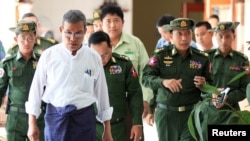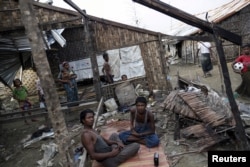Almost three months after insurgents killed nine border guard police officers in Myanmar’s northern Rakhine state, the government loosened its grip on the area this week by inviting a group of journalists and photographers on a three-day tour of places affected by the violence.
Diplomats, rights groups and the press have been calling for media access to Maungdaw and surrounding townships in northern Rakhine since the October 9 attacks, which were claimed by a new insurgent group drawn from the ranks of the country’s oppressed Rohingya Muslim minority.
The military operation to retrieve weapons and arrest suspects has resulted in mass displacement, the deaths of dozens of people, and allegations of widespread human rights abuses, including rape and the systematic torching of villages. The government maintains the stories are fabricated despite mounting evidence to the contrary, including satellite imagery and numerous testimonies.
The trip this week was supposed to be a concession, a chance for members of the media to see for themselves and conduct interviews. But it was tainted from the start. Several international news organizations with bureaus in Myanmar, including the BBC and the Associated Press, were not invited, and the sense among journalists was that the junket was at best a guided tour and at worst an exercise in propaganda.
“Such kind of things happen sometimes in Myanmar. Now that the team is in Maungdaw, they [the authorities] will tell their minister and other people that the journalists were there already,” said Thitsa Hla Htway, secretary of the Foreign Correspondents' Club of Myanmar, in an interview with VOA this week.
“But it is just for show,” he said. “The government’s intention is to exploit them only.”
Thitsa Hla Htway added that he was not calling into question the independence of the reporters and photographers involved, but simply the way the trip was organized.
The Foreign Correspondents' Club of Myanmar took the unusual step of issuing a statement this week that said it had not been consulted about the selection of participants despite an article in local media saying it had. When Thitsa Hla Htway complained to the Ministry of Information, which organized the trip, he was told it was a mistake, he said.
The delegation consisted mainly of local news organizations, including the Myanmar Times, whose management had, until recently, blocked coverage of the crisis in Rakhine and fired a foreign journalist after she wrote an article reporting on allegations of rape there in October. The Japanese newswire Kyodo and the European Pressphoto Agency were represented by Myanmar contributors.
Along the way, the state-backed newspaper Global New Light of Myanmar has covered the comings and goings of the journalists.
“Journalists impressed with extensive media access in Rakhine,” a headline on Friday concluded at the end of the trip.
The article quoted most of the participants, many of whom expressed satisfaction with the proceedings.
“We arrived at the area with no restriction on any individual. We were given the freedom to interview anyone we wanted, anywhere we went. The people answered freely without fear. In terms of media freedom, we were completely free to cover the news. Upon arrival, we had total freedom of expression,” Sithu Aung Myint, a political columnist who works for a fledgling broadcasting outlet called Central News Bureau, was quoted as saying.
“Despite the fact that people were saying it in different ways, we have now seen the true situations with our own eyes," freelance photographer Shwe Inn Thar Khin Maung Win was quoted as saying. "It was found that people’s sayings are totally different from the situations on the ground."
Soe Myint, the editor of Mizzima news, struck a more balanced tone in the report.
“We heard diverse opinions during the trip. There are allegations and also denials. There are also controversial allegations especially over excessive use of force in hunting violent attackers. So, the government should probe into that issue,” the paper quoted him as saying.
There was no specific mention of the arson or sexual assault claims.
Ye Naing, a Ministry of Information spokesperson who led the visits, defended the selection process and the arrangements in an interview with VOA on Friday, saying the trip was "successful" and that there would be more in the future.
“As it is a region still under operation, we can’t bring a lot of local and international media. We made a team with journalists from online, broadcast and print. Then we have to arrange the trip plan. And we have to select the places where it was happening and where it was not. So we have a time limit and it was under pressure and there was a limited amount of journalists. So it looks like a tour. Even though it looks like a tour, we let journalists cover news freely,” he said.
“We have selected those who are easier to call as we had to arrange the trip ASAP. A lot of media were left behind in this trip,” he added.
He said the priority was to visit the three posts attacked on October 9 and go to villages where the military operated in search of suspects.
“And we could show those places where members of three religions are staying peacefully together and there were no attacks there,” he said, referring to communities of Buddhists, Muslims and Hindus.
Thiha Saw, the executive director of the Myanmar Journalism Institute and a member of Myanmar’s Press Council, which helps regulate the industry and pushes for journalistic freedom, said that while the trip was “arranged,” he saw some positives.
“This is something like a testing of the waters for both sides,” the veteran journalist said, adding that it may be easier to judge the result after reading the coverage in the coming days.
“Hopefully you will start to see some independent stories coming out after the trip.”
Aung Naing Soe contributed to this report














